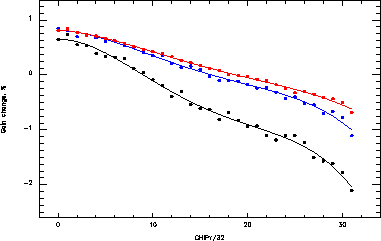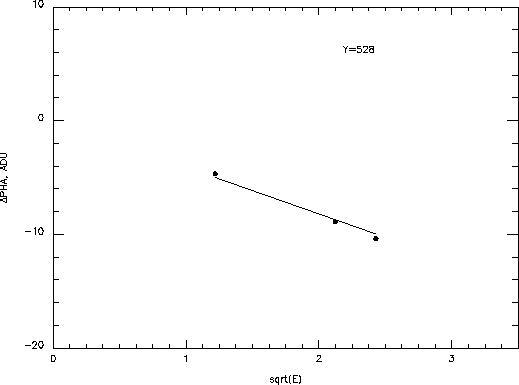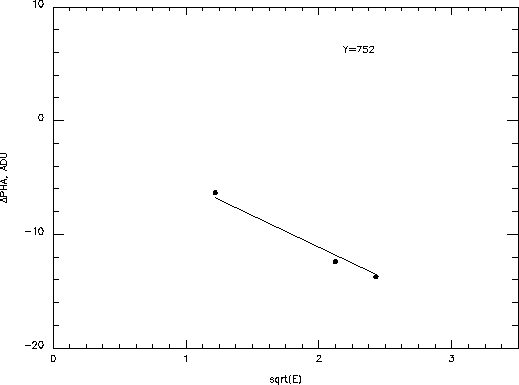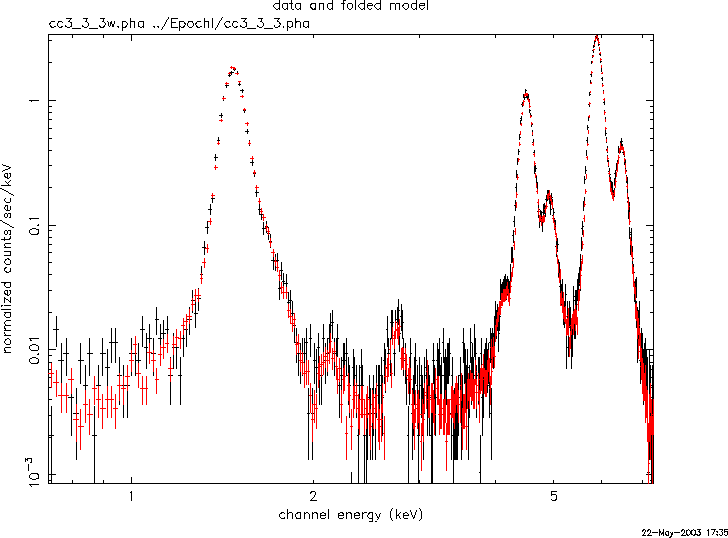
|
This document describes the gain change correction algorithm which was derived for the CTI-corrected data in the FI chips and the uncorrected data in S3. This correction will be implemented in acis_process_events in a future release of CIAO. In the mean time, an equivalent standalone C program and calibration data is available from the Chandra software exchange page.
ACIS spectral response slowly evolves both because of changes in the CTI and evolution of the electronic gain in some of the CCDs. All relevant information can be found in C. Grant's presentation at 2002's Chandra calibration workshop: http://space.mit.edu/~cgrant/acis.html
Two different datasets are available for calibration of the time dependence of ACIS gain:
Our current approach is to derive the gain corrections from the ECS data and to verify their extrapolation to low energies by E0102-72 data. We use the ECS data integrated in a number of short observations spanning 3 months long periods starting in February 2000. This time resolution is adequate to sample the slow gain evolution (§ 3.3).
|
The released ACIS gain and RMF calibration was adjusted to the data taken in early 2000 (February-April), just after the ACIS focal plane temperature was lowered to −120 C. Using these calibration products, we derive the fractional change relative to these epoch by fitting the calibration data taken at later times.
The ECS data are fitted with a model which has 6 Gaussian lines representing the main emission lines in the ECS spectrum. The ratio of the best-fit energies and the nominal energies gives the fractional gain change, ∆E/E, for the given epoch as a function of position.
The E0102-72 spectra are fitted with a physically motivated model consisting of an absorbed bremsstrahlung continuum and a number of emission lines whose energies and flux ratios are fixed based on the HETG observation. The model also includes two multiplicative factors to the line energies for O and Ne emission complexes. The best-fit values of these factors represent the gain change at E ≅ 0.6 keV (O) and ≅ 1.0 keV (Ne).
Figure 1 shows an example of CHIPY-dependence of the fractional gain change at E=1.49, 4.51, and 5.89 keV. To smooth out statistical uncertainties, we use the 4-th order polynomial fits shown by solid lines. Note that the fractional gain change increases at large distances from the readout and towards low energies.
Using the released gain table, we can convert the fractional gain change (∆E/E) to the channel shift for each energy (∆PHA). Without changes in the internal electronics gain, ∆PHA represents the charge loss due to CTI. The phenomenological model of the CTI developed by the ACIS IPI team predicts that the energy dependence at each location is approximately ∆PHA = A E1/2. A similar energy dependence is indeed observed for the time-varying component of ACIS gain in most CCDs (Fig. 2).
|
 |
 |
At least one CCD (I2) shows strong variations in the internal electronics
gain on top of the increase in the CTI. Such changes can be represented by a
linear function of energy, ∆PHA = B E + C. Therefore, the
general function which describes the dependence of gain correction on energy
is
| (1) |
This is an over-determined model because we have to fit three coefficients to three data points. At present, we fix C=0 and B=0 in all CCDs except for I2 and S3. In I2, the internal gain evolution seems to be described by the BE term and so we fix C=0 and fit B in this CCD. In S3, the electronic gain is almost stable but there seem to be a secular zero-point drift by ∼ 2 ADU (http://space.mit.edu/~cgrant/acis.html). Therefore we fix B=0 and fit C in this CCD.
Equation (1) is fit to the data at 32 CHIPY steps for each node of the FI CCDs and for ∆CHIPX=32 steps in S3. Whenever B or C coefficients are needed, they are likely to be independent of CHIPY. Therefore, we average their best-fit values over the CHIPY steps and then refit the A coefficients with B or C held fixed.
The best-fit relation (1) is used to precompute the correction lookup tables, ∆PHA(PHA), for each location and epoch. A simple C program uses these tables to apply correction to the PHA values in either level1 or level2 event files.
After Spring 2000, ACIS gain changes in most CCDs are slow (Fig. 3). Even at early times, the gain changes between the neighboring 3-month intervals are on the acceptably low (0.3% level).
|
External cal. source data do not show any detectable changes in the shape of the ACIS response except for the PHA shifts described above (e.g., Fig. 4 and 5).
|
 |
For a sanity check, we measured the locations of the bright Ka lines in the time-corrected ECS data. Since the corrections were derived from these data, the best-fit line energies should be very close to the nominal values. This is indeed achieved (see, e.g., the following table obtained for node 3 in I3 during Nov2002-Jan2003).
'% Diff' in the following table is defined as (E_measured-E_nominal)/E_nominal*100%
CCD: 3, NODE: 3,
AlKa,1.487keV TiKa,4.510keV MnKa,5.898keV
yseg % Diff % Diff % Diff
0 -0.081 -0.120 -0.124
1 0.054 -0.111 0.036
2 -0.087 -0.089 0.010
3 0.087 -0.111 -0.014
4 0.101 -0.144 -0.073
5 -0.128 -0.111 -0.044
6 -0.101 -0.069 -0.049
7 -0.262 -0.118 -0.090
8 -0.081 -0.035 -0.063
9 -0.027 -0.113 -0.066
10 0.034 -0.100 -0.054
11 0.007 -0.075 -0.061
12 -0.027 -0.031 -0.109
13 -0.161 -0.013 -0.088
14 -0.155 -0.011 -0.088
15 0.161 -0.129 -0.081
16 -0.094 -0.086 -0.078
17 -0.087 -0.084 -0.083
18 0.182 -0.027 -0.078
19 0.067 0.000 -0.073
20 0.202 -0.109 -0.054
21 0.027 0.000 -0.110
22 -0.161 -0.206 -0.085
23 0.047 -0.244 -0.122
24 -0.020 -0.222 -0.129
25 -0.148 -0.197 -0.137
26 0.040 -0.047 -0.102
27 0.256 -0.111 -0.110
28 0.101 0.031 -0.070
29 0.148 -0.111 -0.117
30 0.175 -0.111 -0.163
31 0.161 -0.222 -0.259
----------------------------------------------------------------
Mean 0.007 -0.097 -0.085
Standard 0.129 0.069 0.052
deviation
To verify the time-dependent gain correction at low energies we used the calibration observations of E0102-72. The summary of the results is given below. Essentially, the line energies for both O (E ≈ 0.6 keV) and Ne (E ≈ 0.9 keV) came out within 1% or better of their nominal values.
O_gain and Ne_gain in the following table are defined as the ratio of the
measured and nominal energies for the O and Ne complexes.
CCD OBSID Epoch chipx chipy O_gain Ne_gain
I0 1542 VI 257:512 513:544 1.0075 0.9970
I0 2840 VIII 257:512 513:544 1.0075 0.9970
I1 444 I 1:256 97:128 1.0073 1.0040
I1 445 I 1:256 481:512 1.0320 1.0240
I1 1543 VI 257:512 481:512 1.0072 1.0060
I1 2841 VIII 257:512 449:480 1.0073 1.0060
I2 1544 VI 257:512 513:544 0.9990 0.9970
I2 2842 VIII 257:512 513:544 1.0074 0.9970
I3 1537 VI 1:256 481:512 0.9987 1.0025
I3 2839 VIII 1:256 449:480 0.9988 0.9970
I3 1536 VI 257:512 481:512 1.0073 0.9970
I3 2838 VIII 257:512 449:480 1.0072 0.9970
I3 420 I 513:768 97:128 1.0083 1.0100
I3 140 I 513:768 289:320 1.0073 0.9970
I3 136 I 513:768 449:480 1.0128 1.0140
I3 1535 VI 513:768 481:512 1.0075 0.9970
I3 2837 VIII 513:768 449:480 1.0074 0.9970
I3 439 I 513:768 673:704 1.0085 1.0085
I3 440 I 513:768 897:928 1.0048 0.9970
I3 1533 VI 769:1024 97:128 1.0072 1.0060
I3 2835 VIII 769:1024 97:128 1.0074 1.0060
I3 1534 VI 769:1024 481:512 1.0075 0.9970
I3 2836 VIII 769:1024 449:480 0.9988 0.9970
S2 1539 VI 513:768 481:512 0.9988 0.9970
S2 2847 VIII 513:768 481:512 0.9987 0.9970
The time-dependent gain correction will be implemented in the future release of acis_process_events. In the meantime, we provide a stand alone C program, corr_tgain.c. The only external library required by corr_tgain is CFITSIO which is widely distributed with FTOOLS.
Note also that corr_tgain should be applied to the CTI-corrected data in the I0-I3 and S2 chips (there is no reason to use uncorrected data in these chips!). The program will not modify the data for other FI CCDs and S1. Note that S0, S1, S4 and S5 are used primarily for grating observations so the time-depenedent gain change is less important.
Here is a typical data correction thread:
cp evt2.fits evt2-save.fits
Note that corr_tgain will change the PHA column in the events file and the original PHA values cannot be easily restored. Therefore, always save your data and run corr_tgain only once!
dmkeypar evt2.fits DATE-OBS ; pget dmkeypar value
2002-02-05T22:41:52
% ls corrgain*.fits corrgain2000-01-29.fits corrgain2001-02-01.fits corrgain2002-02-01.fits corrgain2000-05-01.fits corrgain2001-05-01.fits corrgain2002-05-01.fits corrgain2000-08-01.fits corrgain2001-08-01.fits corrgain2002-11-01.fits corrgain2000-11-01.fits corrgain2001-11-01.fits
Select the latest file still appropriate for your data. For example, for the observation date above (February 5, 2002) the correct file is corrgain2002-02-01.fits. PHA correction is performed by the following command:
corr_tgain evt2.fits -tgain corrgain2002-02-01.fits
acis_process_events\
infile=evt2.fits\
outfile=gov.fits\
acaofffile=none stop=none\
gainfile=/soft/ciao/CALDB/data/chandra/acis/bcf/gain/acisD2000-01-29gain_ctiN0001.fits\
gradefile=none\
apply_cti=no doevtgrade=no calculate_pi=yes check_vf_pha=no\
clobber+
mv gov.fits evt2.fits
Note that the corr_tgain calibration was derived for the CTI-corrected data in the FI chips. We expect that a similar correction applies to the non-corrected data as well. In this case the user should run corr_tgain as usual but use a different gain file on step 4.